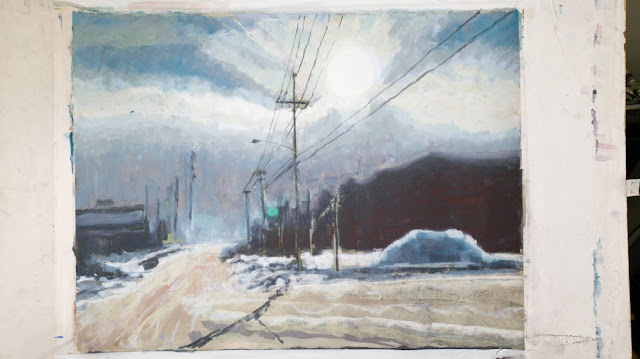Flexibility in the moment is critical to good painting. I believe that over thinking and too much concern for the outcome are limiting and does not allow a full expression.
This painting was done for my sister in law Sue. Apparently she had sent me this picture a couple of years ago. This was one of her favorite pictures. While they were out visiting us with my mom I asked her to send it to me again so I could paint it.
This is the first time I have painted from a reference photo on my phone. It took me a while to figure out the balancing act of keeping the picture open and balancing the watercolor tray and establishing the color, composition, and values within the painting.
Beyond the challenge of painting from my phone was the challenge of painting an out of focus subject. The snowflakes in this picture were stuck to the windshield and were not falling. That was why the rest of the subject matter was out of focus. This also was the first time I painted snow for the most part.
The first thing to remember when dealing with new situations is to give yourself enough time. Time has a way of removing pressure from the moment. If you know you have all the time you need, then problem solving does not have to be pushed. Construction priorities when followed in the proper order really help with the foundation of the painting. Knowing you are always going to do your best without creating unrealistic expectations help you stay focused on the task at hand. In the end every painting is an endpoint and a starting point. The culmination of years of painting are captured in every painting and also the starting point of some new process, thought, perspective or technique.
Detail within the painting as with everything is about personal preference. I love detail. The question of how much detail to add can be tricky I knew I had to add the snowflakes on the wind shield because Sue mentioned how important they were to her. The question became not if but how I was going to add the snowflakes. They were the last thing added. Because they are the closest thing to the viewer they had to be the last thing I painted. When you think of snowflakes you may think that most everything is random. When I was thinking about the size and placement of the snowflakes on the windshield I thought about all of the factors that resulted in their placement. They were anything but random. So ina quick and loose manner I copied the size and location of the snowflakes. If I just put down random snowflakes
it probably not read as realistic. You are a slave to the details when you are rigid. When you remain open and flexible your choices expand.
The finished painting.















